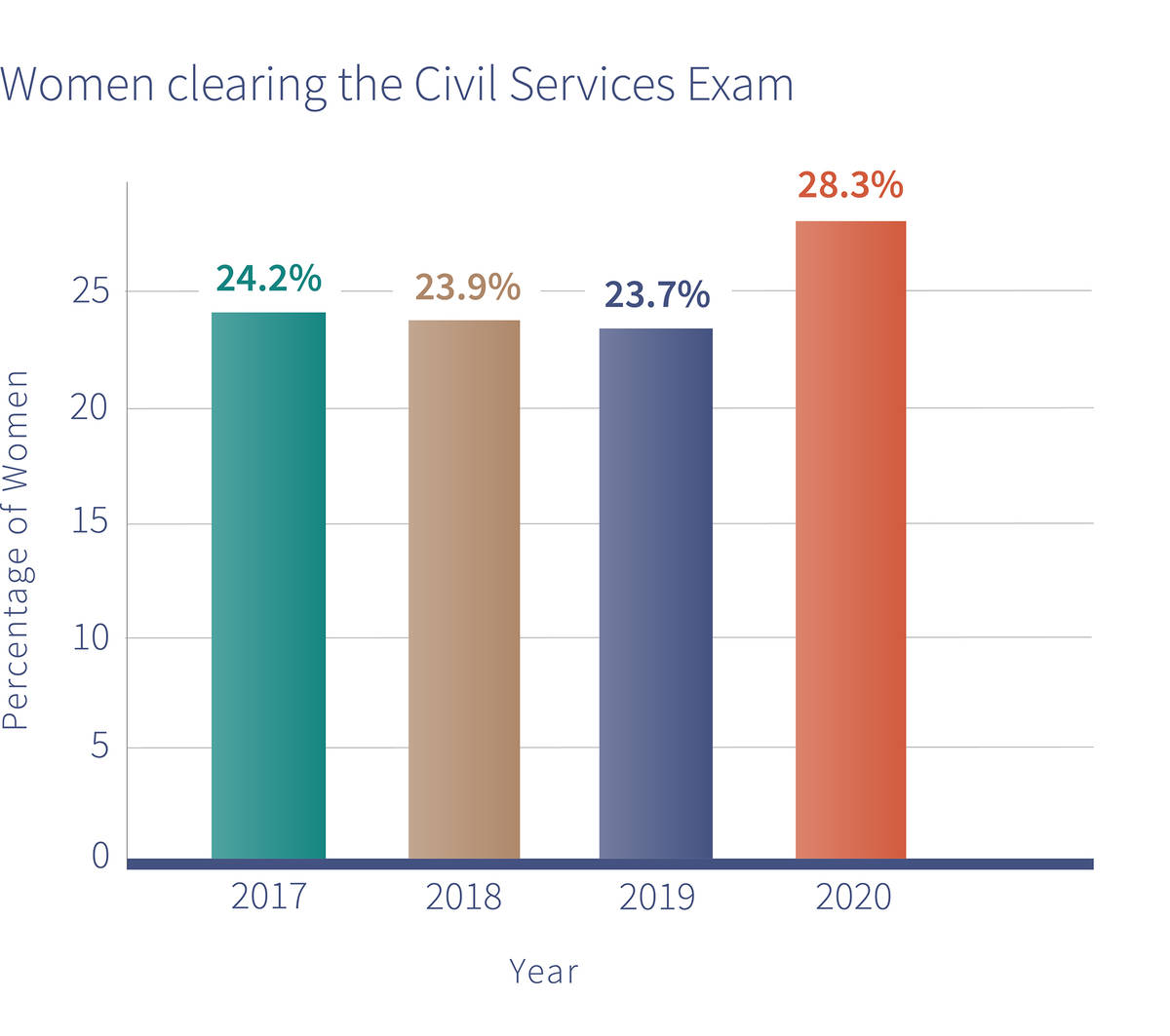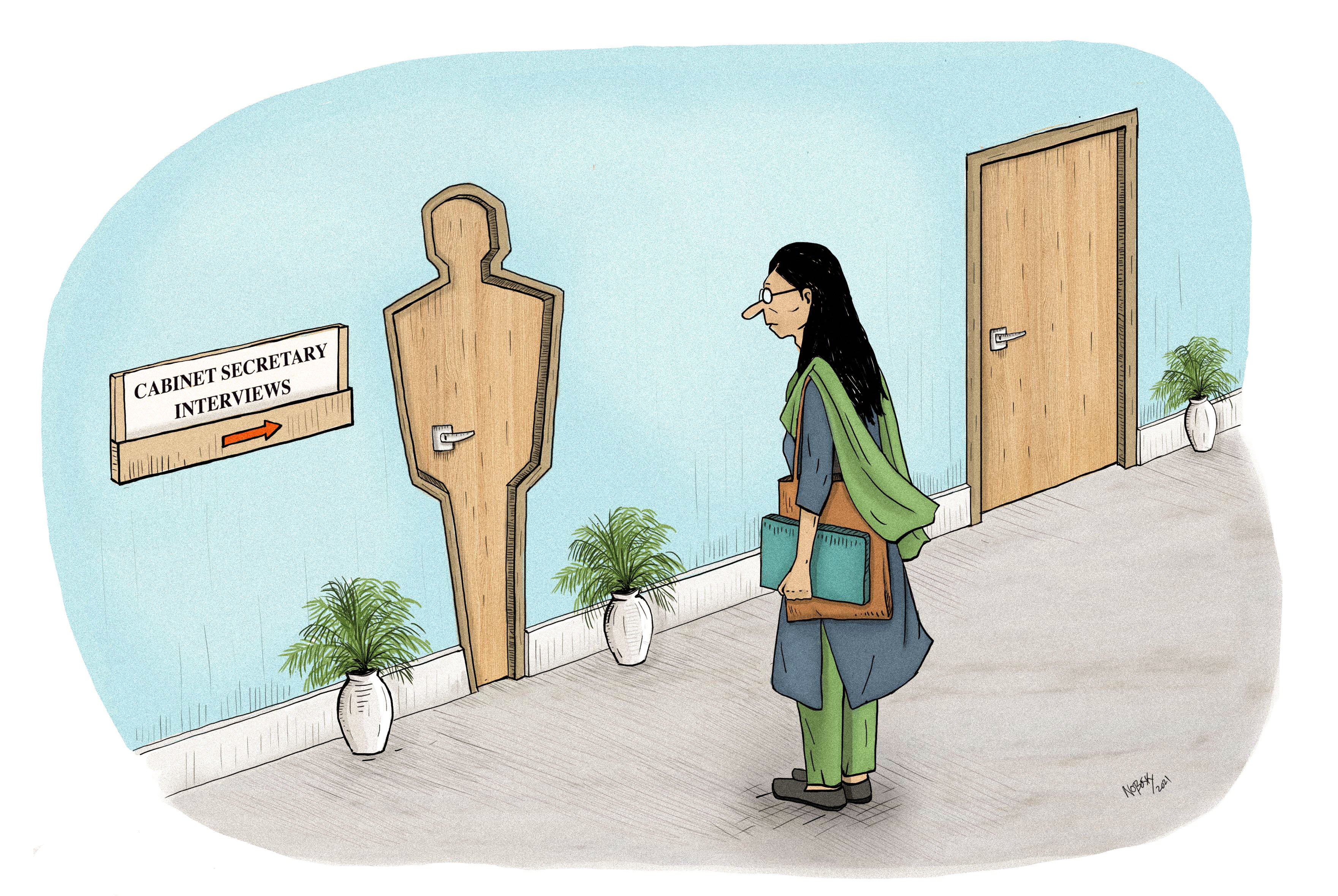Where are the Madams?
Until the 1950s, there was not a single woman in the Indian Civil Service. In fact, CB Muthamma, the first woman to join the services (and the first woman IFS officer) had to sign a declaration that she would quit the service if she got married.
We've come a long way since then – not only have such sexist and discriminatory practices ceased to exist, but women today bag top ranks in the annual civil services examination. The Union Public Services Commission (UPSC) actively encourages women candidates to apply by making it explicit in the notification issued for the test, even waiving off the application fee. In the 2020 exam, two among the three toppers were women. Union Minister of State Jitendra Singh also tweeted about the equal number of men and women in the top 20 ranks. According to the Times of India, 28.3% women made the cut this year, the highest in the last four years (see graph).
Why then, despite growing numbers of female recruits, do we see fewer women in top leadership and decision making positions in the country?

Beyond the numbers
Data accessed by The Print in 2019 revealed that out of 32 chief secretaries across states and union territories, only one was a woman. Among 88 secretary-rank officers in the central government, 11 were women. Few women rise to the top echelons of bureaucracy. For example India hasn't seen a single woman cabinet secretary, the highest post in the bureaucracy, till date. Retired IAS officer TR Raghunandan has stated that there’s a selection bias against women for stronger postings.
For this reason, it’s important to address the systemic issues that underpin lower representation. Even among urban, more privileged communities, gendered distribution of work – women take on the bulk of domestic labour globally – sets them back from pursuing more challenging opportunities. Policy making cannot be truly effective until it’s intersectional, integrating technical know-how with social and political awareness. This would mean accounting for the lived experiences of the communities they seek to benefit.
Sanitation measures are a worthy example. Millions of women in rural India who lack access to toilets risk disease and resort to open defecation, often waiting until dark to relieve themselves to minimise their risk of assault. A BMJ Global Health study on sanitation insecurity in rural Odisha revealed that women’s ability to attend to their urination, defecation and menstruation needs were strained by the gendered roles they were expected to uphold and their dependence on social support systems.
So while building toilets is a necessary first step, it’s also important to address the underlying issues that may prevent communities from fully utilising their benefits. Women decision makers have a more nuanced understanding of these challenges. As the BMJ study proposed, sanitation programming needs to tackle the social norms that make women’s sanitation needs second to the obligations they have to their households and families.
Cultivating large-scale behavioural change is key to chipping away at social norms and gendered perceptions of labour. Here are some approaches that can be adopted:
- Gender bias can take on subtle forms and it’s important to unravel the layers by bringing in perspectives such as intent vs impact. It’s an effective communication process that also figures in the discourse around sexual harassment at the workplace. The civil services can benefit from this approach given the government’s inclination to achieve a more balanced gender ratio.
- Including the voices and concerns of all genders is key to addressing larger questions of roles, responsibilities and growth.
- To enable women to climb up the ladder, providing access to leadership and mentoring opportunities is essential.
The way forward
In 2014, the Department of Personnel and Training (DoPT) introduced the Civil Services Competency Dictionary, in an effort to move from a rule-based administrative system to a competency-based one. The dictionary was developed in consultation with various stakeholders including senior civil servants, cadre controlling authorities, among others. It was a significant move towards bringing large-scale administrative reform.
The Dictionary highlights the importance of behavioural characteristics like traits, motives and social roles (in addition to baseline knowledge and skill) for effective performance. The four major competencies part of the framework include ethos, ethics, equity, and efficiency. Within equity, the competencies covered are consultation and consensus building, decision making, empathy and delegation.
While these are imperative, the ambit of equity needs to be expanded to include diversity and gender sensitivity. This would mean developing and implementing training programmes that probe at the conscious and unconscious biases that seep in due to conditioning and socioeconomic factors. These can be delivered by experienced researchers-facilitators, in the form of workshops, group discussions, seminars and more. Leading online learning platforms like edX, Coursera, and even esteemed universities like MIT have courses on gender analytics, equity, diversity and inclusion in the workplace, gender and technology, among others.
India has a slew of women civil servants doing exemplary work across sectors. Annies Kanmani Joy, a Deputy Commissioner in Kodagu, Karnataka, received wide acclaim in 2020 for helping contain the spread of the COVID-19 virus in her district. Hari Chandana Dasari, an IAS officer of Telangana cadre, has contributed towards Hyderabad's green revolution by putting in place significant initiatives for the recycling of plastic. Uma Mahadevan (Principal Secretary, Panchayat Raj, Karnataka) has done notable work in nutrition and education, particularly with anganwadi children, workers and ASHA groups.
Women’s social and economic empowerment is hinged on access to quality education, healthcare and employment opportunities. Since policies have a disproportionate impact on them, mainstreaming gender in public service delivery is the need of the hour. As outlined earlier, tackling internal and external biases, including more women in decision making, and providing leadership opportunities will go a long way. In turn, this will have the cascading effort of encouraging participation from more women candidates.



Add new comment